Installing a toilet with your own hands: features of installing toilets of various designs
The work of installing new plumbing is a source of concern for many novice craftsmen.The variety of design solutions for plumbing fixtures and methods of connecting them requires the contractor to know the intricacies of the process.
We will try to reveal the main ones and analyze how to correctly install a toilet with your own hands without the help of plumbers.
The content of the article:
- Design options for modern models
- General recommendations for installing toilets
- Connection options for plumbing fixtures
- Installation features of compact models
- Photo guide for assembling and installing the compact
- Installation of a monoblock toilet
- Installation of suspended structures
- Conclusions and useful video on the topic
Design options for modern models
The range of plumbing fixtures on the market is varied. Any owner has the opportunity to choose presentable and functional equipment to suit his own taste and budget.
In addition to traditional floor-standing models, manufacturers offer a wide selection of wall-hung and built-in devices. The drain tank in them can be attached to the wall or connected to the base of the plumbing fixtures.

The latest toilet models also differ in the design of key components.
The output discharge is:
- horizontal;
- vertical;
- oblique.
The type of outlet drain should be taken into account when choosing a model.If your plans do not include altering the sewer pipe supply, then in the installed model the drain should be arranged according to the same principle as in the dismantled one.
Inconsistent drains and plumbing supply, provided that it is not a toilet with an outlet, are almost impossible to combine as tightly and efficiently as possible.
Fixation of plumbing fixtures to the floor is carried out using specially made two or four fastening points. But you can also find models in which the corners included with the product are used for fastening to the floor.
General recommendations for installing toilets
A new plumbing fixture can be placed in the place of the old one, or you can choose another “corner” for it, making a small redevelopment in the bathroom.
Preparation of tools and materials
To connect the tank to the water supply you will need a flexible hose. It usually comes included. For connection to sewerage – rigid fan pipe or a bendable corrugated cuff.

To assemble the structure and connect to communications you will need:
- hammer drill or impact drill;
- a set of screwdrivers with flat and Phillips blades;
- set of wrenches;
- building level;
- a simple pencil or marker;
- stationery knife;
- roulette;
- chisel;
- hammer.
If the installation of plumbing fixtures will be carried out on tiles, then it is also necessary to prepare a “ballerina” or a spear-shaped drill for working on tiles. To make holes for installing fasteners, you will also need an 8 or 10 mm drill.
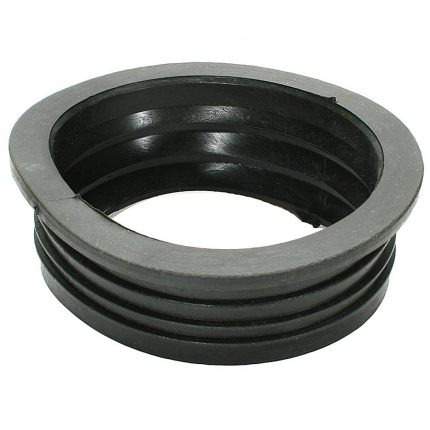
Auxiliary materials will also be required:
- metallized tape;
- silicone sealant;
- FUM tape;
- polyethylene film;
- moisture-absorbing piece of fabric;
- container for collecting liquid.
Depending on the type of model being connected and the installation method, cement mortar may also be required.
Removing an old toilet
Removing an old toilet is one of the most time-consuming operations.
The work is carried out in several stages:
- Turn off the tap.
- Disconnect the hose going to the tank from the water supply and drain the water from it.
- The empty tank is removed from its mounts.
- Unscrew the nuts located on the back of the toilet and disconnect it from the sewer. To loosen the drain, the toilet needs to be rocked from side to side.
- Drain the remaining water from the toilet by tilting the bowl forward.
- The sewer hole closer to heaven is cleared of dirt and temporarily blocked with a rag gag or a wooden plug of suitable diameter.
The easiest way to remove the bolts is to hold the head with an open-end wrench and unscrew the nut with an adjustable wrench. If the threaded connections are heavily slagged with salt deposits or rusted.
To make the task easier, use universal lubricant “WD-40”, which can loosen deposits in a matter of minutes. In the absence of one, you can use vinegar or kerosene.
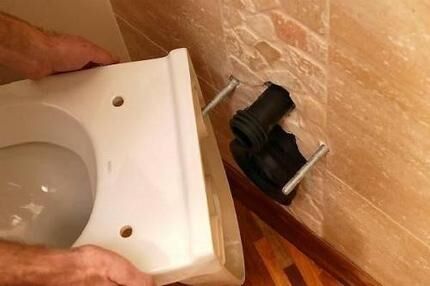
If rotten taffeta or any other support is found under the dismantled toilet, it must be removed.This can be done with a hammer drill, nail puller or chisel.
In older houses, drains on sewer pipes are often secured with cement coating. The easiest way to knock down dried mortar is with a chisel, pricking it in several places. Read detailed instructions on dismantling an old toilet. Further.
Sequence of assembly of the structure
For safety reasons during transportation and to further save space, plumbing fixtures arrive in stores disassembled. To enable self-assembly, each product comes with illustrated instructions.
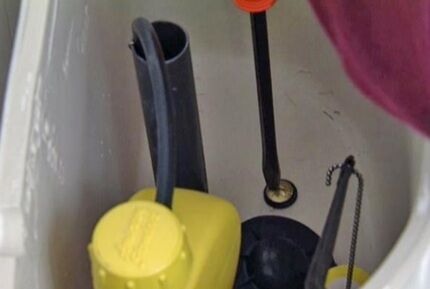
The general outline of the structure assembly is as follows:
- A drain mechanism is installed in the tank, which is included with the device in an already assembled form. When installing the mechanism, it is important to examine the contacting surfaces. If burrs are found, remove them.
- A sealing rubber washer is placed on the mechanism. The device is immersed in the tank and secured with a nut.
- A tank equipped with a drain mechanism is attached to the shelf of the bowl. The elements are fixed using nuts and bolts, after placing washers and rubberized seals on the fasteners.
When installing tank fittings, plastic filler valve nuts and drain mechanism tighten by hand without applying excessive force. During the tightening process, it is necessary to hold the mechanism itself, thereby protecting the gaskets from turning and damage.
The base for installing the plumbing fixture must be level. If the floor surface or base of the toilet is uneven, rubber or plastic pads must be placed under the sole during installation before final tightening. The position of the device is leveled using a building level.

Chopiks can also be used for this purpose. Holes are made in the floor for their installation. The chopsticks are set according to the level, deepening to the required depth. The toilet is secured with screws.
The base of the bowl is placed on the prepared base. Marks are made at the fastening points, which act as a guide for drilling mounting holes. Dowels are driven into the mounting holes.The fasteners inserted through the sealing nuts are tightened and closed with plugs.
Connection to the sewer
The most cost-effective and easiest to implement option for connecting to a sewer is using a corrugated or eccentric cuff. This connection method saves in cases where it is difficult to determine the exact distance from the sewer pipe outlet to the toilet outlet, or when the plumbing fixtures are installed in a place that is inconvenient from an installation point of view.

Remove the wooden cap from the neck of the sewer outlet and remove the rag plug. The bell is cleaned of accumulations of dirt, rust and solution residues. One end of the cuff is inserted into the neck of the sewer outlet. The seam is sealed by covering it with 2-3 layers of the compound. The other end of the cuff is attached to the outlet.
If the installation has to be done in a cast iron socket, then the cuff is inserted with the petal part into an adapter measuring 123 x 110 mm. The free end of the adapter is buried in the cast iron socket, covering the joints of the elements with plumbing sealant.
To connect the outlet of a plumbing fixture, the free end of the cuff is inserted into the protrusion and turned until it stops so that the holes in the trim completely coincide.
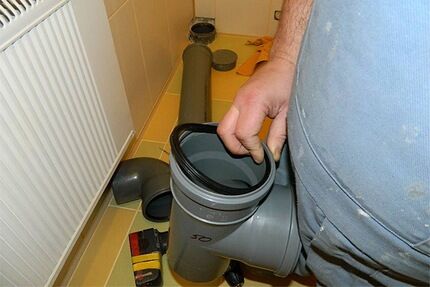
The connection is sealed and tested experimentally by pouring 8-10 liters of water into the toilet. If a leak is detected, the connection is resealed and checked.If no leaks are found, you can begin fixing the toilet.
To create a more reliable connection, it is better to connect the outlet through a drain pipe. In addition, when using a drain pipe, the plumbing fixture acquires a more presentable appearance.

When working with vent pipes, you should remember that undercutting is contraindicated for them, and their sealed structure cannot be changed during the installation process. We also suggest that you read our other article, which describes in detail toilet connection diagrams to the sewer.
Connection to water supply
At the final stage of installation, a connection to the water supply system is made. The water supply is made from the top or bottom of the tank, using the flexible hose that comes with the kit. One end of it is screwed to the outlet of the tank, and the other to the water pipe.
The lateral supply can be made from the right or left side of the tank. Therefore, at the stage of purchasing a product, you should choose the method of supplying water, focusing on how the pipes are laid in the bathroom.
It is better to give preference to devices with bottom supply. In them, water enters the tank from below, due to which the noise level during collection is significantly lower.
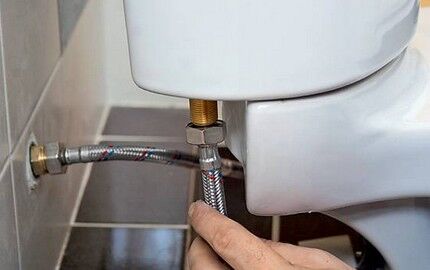
When purchasing a flexible hose, when choosing the length of the product, you need to focus on the distance from the connection point on the water pipe to the connection point of the toilet filler mechanism. For reliability, add a margin of 15-20 cm to the obtained value.
The thread at the joints can be either external or internal. Its size is 1/2 or 3/8. For docking, adapters and FUM tape may be required.
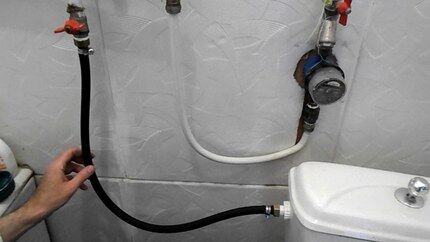
Connection options for plumbing fixtures
As already noted, there is a wide variety of plumbing fixtures on sale, which can have one of three types of connection to the sewer: with horizontal, vertical and oblique outlet. Each of them has its own characteristics.
Option #1 – with vertical outlet
Such models are popular in European countries. Their design is such that the siphon located in the bowl and the outlet pipe “look” down.

To connect a plumbing fixture with a vertical outlet, perform the following steps:
- A screw flange equipped with a locking device is installed at the exit point of the drain pipe.
- A sewer pipe is placed in the center of the flange, clamping it as it turns.
- The toilet is “mounted” on the flange, securely securing the outlet pipe.
The connecting parts of the flange and the vertical outlet of the toilet are standard. There shouldn't be any difficulties connecting them.
The installation and connection process is presented in the following selection:
The screw flange collar must fit tightly into the outlet socket and must be turned during installation to ensure complete articulation. The sealing ring located between the flange and the toilet flush will ensure the reliability and good tightness of the clamp. Step-by-step instructions for installing a toilet with a vertical outlet can be found in this material.
Option #2 – with horizontal outlet
Plumbing fixtures with horizontal outlet have become one of the most popular in our country. The relevance of installing such equipment is explained by the specifics of the wiring of the sewerage system in Russian apartments.
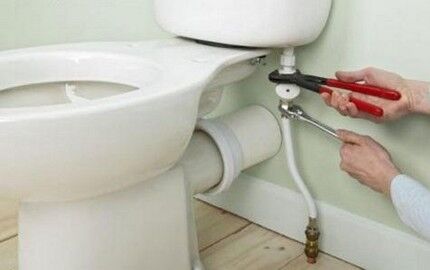
The horizontal outlet is located at the back of the bowl or base and is directed backwards. Models with this design are installed end-to-end with the wall, connecting to any type of sewer riser location.
The connection is made using pipes of the appropriate size. The connection is sealed by placing a sealing rubber inside the pipe.
Direct connection is made only if the sewer system is made of plastic. To connect to cast iron pipes, the circumference of which rarely has an ideal shape, cuffs and eccentrics are used.
Option #3 – with oblique release
The socket in models with an oblique outlet is located at an angle of 45° relative to the floor surface. Models with an inclined outlet are superior to their counterparts in that they are less likely to become clogged, since this design makes it possible to create less resistance when moving solid sewage.
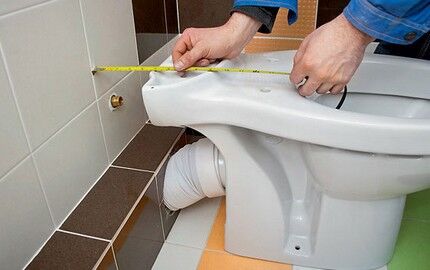
Connecting a device with an oblique outlet to the sewerage system can be done in one of three ways:
- By direct connection through the sewer branch socket. They are chosen when there is no need to move the plumbing fixture, and the direction of all elements clearly coincides. The toilet outlet is treated with soapy water and buried in a socket equipped with a cuff.
- Connection via eccentric. A socket with a center offset of 5 cm, equipped with a sealing gasket, is mounted in the sewer outlet and by rotating the toilet is shifted to the right or left side.
- By installing a corrugated outlet. The use of corrugation makes it possible to deploy the relative oblique sewer outlet device even at an angle of 90°.
A flexible outlet, although convenient, is far from the best means for connecting toilets with an oblique outlet. It should be used only in extreme cases, when other methods are not possible.
To find out in more detail how to install a toilet with an oblique outlet, go to link.
Installation features of compact models
The technology for correct installation of floor-standing toilets of compact models includes seven main stages:
- The toilet bowl is moved as tightly as possible to the drain hole and checked whether the outlet coincides with the sewer pipe.
- If there are small displacements, the device is connected to the sewerage outlet using a corrugated pipe.
- The plumbing fixture with the connected corrugated pipe is moved towards the wall, making sure that strong creases and bends do not form on the pipe.
- The ends of the connecting element are covered with a thin layer of silicone sealant.
- Having adjusted the position of the device, use a pencil to mark the outline of the boundaries of the base of the device and the points where it is planned to drill holes for deepening the dowels.
- The toilet is moved to the side.At the designated points, holes are made with a diamond drill with a diameter equal to the size of the dowels used.
- Plastic plugs are inserted into the holes. The toilet is “reinstalled” in its original place. Bolts are screwed into the prepared holes.
Tip: to make it easier to put the corrugated pipe on the outlet, its end must be coated with liquid soap on the inner walls.
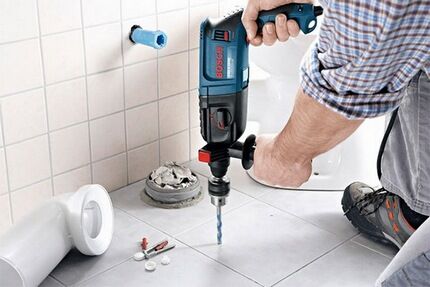
To ensure the tightest possible fit of the toilet sole to the floor covering, silicone is applied along the intended installation counter of the device. The toilet itself is then placed in its original place, guided by the intended contour.
To fix the plumbing fixture, washers and screws threaded through the holes in the heel are tightened extremely carefully. Under no circumstances should they be driven in!
Photo guide for assembling and installing the compact
Let's look at the process of installing a toilet using the example of assembling and fastening Chinese PORTA plumbing fixtures. An excellent product with a 25-year manufacturer's warranty and a very attractive price.
We will assume that we have successfully completed the preparatory stage; now we will proceed directly to installing the plumbing equipment and connecting it to communications:
Installation of a monoblock toilet
Models in the “monoblock” category are supplied to the market assembled. They do not require adjustment of the drain mechanism, since all fittings are already adjusted at the factory.
Otherwise, the installation technology for monoblock models does not differ from the installation of compact toilets. Connecting to communications and fixing the device itself is carried out in an identical way.
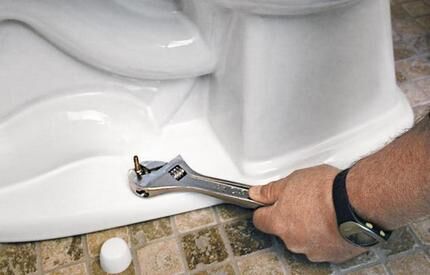
Important point! If the holes in the toilet bowl are made at an angle relative to the floor surface, then they must also be drilled at an angle. We also recommend reading the article about choosing monoblock toilets.
Installation of suspended structures
The installation of suspended models should be carried out as part of a major overhaul before finishing work begins. To properly install a wall-hung toilet, it must be attached only to a solid wall made of solid brick or concrete, which can withstand considerable loads.
When choosing a place to install a suspended structure, you should take into account that the shorter the pipe section connecting the plumbing fixture to the sewer, the easier it will be to clean it in case of blockage.
Work on installation of a suspended structure performed in the following sequence:
- Marking. When choosing a location, it is important to consider the location of the outlet in order to obtain the optimal pipe slope.
- Sewage and water supply. A sewer pipe D 110 mm is installed at the placement point.
- Frame installation. A rigid frame is assembled, adjusting its position using adjustable legs and fixing it with dowels and anchor bolts.
- Installation of a toilet bowl. It is placed at a height of 40 cm from the floor level.
- Water supply to the tank and connection of the outlet to the sewer outlet. A rigid pipe is used to supply water, and a corrugated pipe is used to connect the outlet.
Then the niche is sealed.You can line the niche with any finishing material, not forgetting to leave an inspection window to allow access to the tank in case of carrying out preventive measures or eliminating an emergency situation.
Before installing the frame, it is important to level all planes using a building level. The frame itself is attached to the wall using support brackets, and to the floor using anchor bolts.
Conclusions and useful video on the topic
A few tips from experienced professional plumbers will help you avoid serious mistakes and complete your installation faster.
How to install the tank correctly:
Video tutorial on equipment installation:
Subtleties of installing hanging plumbing:
If done correctly, installing a plumbing fixture yourself should not cause any particular difficulties. The main thing is not to rush to put it into operation immediately, allowing time for the silicone to solidify thoroughly.
Have you already installed a toilet yourself and have valuable experience that you can share with visitors to our website? Please leave comments in the block below. There you can ask questions about the topic of the article or give valuable advice to those who have never encountered such work.




I am used to doing everything in the house with my own hands; my father taught me this since childhood. Therefore, installing a toilet in a combined bathroom was no exception. I adhere to the rule: if you want it done well, do it yourself. I bought all the components in advance, I have the tools. Of course, I struggled a bit with the tiles on the floor and dismantling the old toilet, but everything turned out neatly. One can handle it quite well.
The biggest problem for me was dismantling the old toilet, which was as old as the house. It couldn’t be removed by itself; it had to be naturally broken, and also ensure that the sewer pipe, also old, did not deteriorate.
And the connection of the new toilet (I have an oblique outlet) was made with corrugation, because other options were not suitable.
On my own behalf, I will say that if the plumbing is old, then it is better to change both the toilet and the sewer pipe, then the whole process of dismantling and connecting will be much simpler.
I must say that installing a toilet is quite complicated, although at first glance you wouldn’t be able to tell. Personally, the first three times I fiddled for a long time, then it became a little easier. Therefore, I recommend that beginners call a specialist or a friend who understands. But if you have the desire and straight arms, then why not try.
Everything is too abstruse, it could be simpler. There are also cuffs: straight and offset. With their help, you can move the toilet closer to the wall.